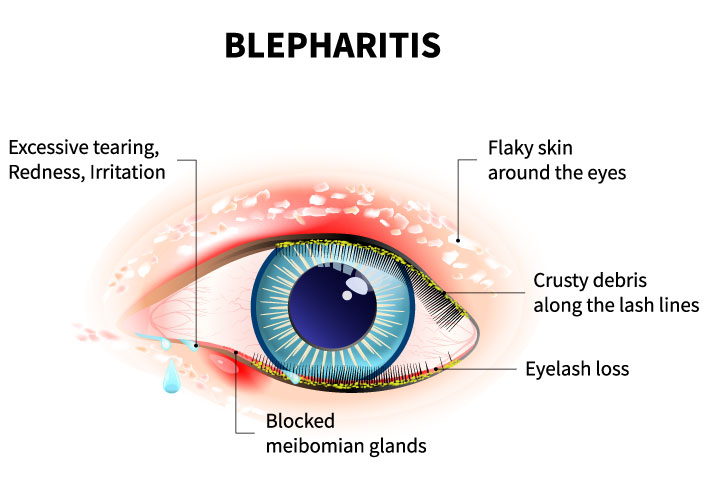Blepharitis Types and Causes

A common disorder of the eye, blepharitis, is a condition in which there is visible inflammation in the eyelids. Bacteria causes irritation and the eyelids become red and itchy. Though it does not cause permanent damage to vision, blepharitis causes discomfort to patients. Women in their peri- and post-menopausal stage are more prone to the dysfunction of the meibomian glands.
A common disorder of the eye, blepharitis, is a condition in which there is visible inflammation in the eyelids.
Bacteria causes irritation and the eyelids become red and itchy. Though it does not cause permanent damage to vision, blepharitis causes discomfort to patients. Women in their peri- and post-menopausal stage are more prone to the dysfunction of the meibomian glands.
Causes of anterior blepharitis
Staphylococcal infections or seborrheic dermatitis are the main causes of anterior blepharitis.
Staphylococcal infections
Symptoms such as mild sticky eyelids, thicker margins of the eyelid, and missing eyelashes occur due to Staphylococcal blepharitis.
Although Staphylococcus bacteria are commonly present in the skin, nose, buttocks, and the surface of the armpits, they can enter the human body through a cut or insect bite of the skin or through skin openings while using medical equipment, such as urinary catheters.
The bacterium Staphylococcus causes a group of infections, from minor skin and soft tissue infections to invasive infections called Staphylococcal infections or staph infections. Among the many varieties of Staphylococci, the bacterium Staphylococcus aureus consists of methicillin-resistant Staphylococcus aureus (MRSA), which has developed resistance against certain antibiotics such as flucloxacillin, which is commonly used for staph infections. The cause of most infections has Panton-Valentine leukocidin (PVL)-Staphylococcus aureus, which generates a toxin called PVL that can kill white blood cells and thus result in recurring skin infections.
Even though infections can affect healthy individuals, people with a weak immune system, such as patients undergoing chemotherapy, are more prone to these infections.
Seborrhoeic dermatitis
Seborrhoeic dermatitis is a type of eczema visible in places where the sebaceous glands are active. The yeast Malassezia furfur is said to activate seborrhoeic dermatitis. Sebum production is, however, not related to the severity of eczema.
Some individuals are free from eczema even though the sebum production is higher. Though the exact cause of Seborrhoeic dermatitis is not understood completely, conditions such as depression, epilepsy, heavy intake of alcohol, and medications such as psoralen, lithium, and interferon induce the risk of Seborrhoeic dermatitis.
Blepharitis could be due to metabolites such as reduced fatty acids or an increase in the levels of oleic acid, cholesterol, and/or triglycerides. Symptoms such as red scaly margins in the eyelid are visible as a result of seborrhoeic dermatitis.
Causes of posterior blepharitis
In posterior blepharitis, problems are associated with the inner part of the eyelid. The eyelid margins have minute oil glands, called meibomian glands. These are positioned in both the lower and upper eyelids with each lid carrying anywhere from 15 to 20 glands.
The openings of the meibomian glands lie inside the line of the eyelash, typically on the eyelid edges. The oil percolates slowly when the eyes are blinked; however, the gland collapses when it is empty.
The oil produced by this gland merges with the watery component in the eye and, together, a tear film is created. This oily layer provides a coating to the water layer and protects the water from evaporation. When the quality or quantity of the water or oil is altered, symptoms such as eye irritation can arise.
Meibomian blepharitis is classified by symptoms such as poor tear quality and redness in the eyelid lining. This is because the glands in the eyelids produce oil irregularly, which also favors bacterial growth. The secretions of the meibomian glands are broken down by the bacteria which can cause irritation to the eye while simultaneously giving a foamy look to the tear film. The excess oil that is formed along the edge of the eyelid will lead to inflammation, as well as the generation of crusty flakes.
The inflammation of the margin of the eyelid can put a ceiling on the meibomian gland slits. This obstruction will decrease oil production, thereby causing the oil that stays in the gland to become thick and contaminated.
What causes meibomian gland dysfunction?
Although there are many conditions that can lead to the dysfunction of the meibomian glands, one particular skin condition is known as rosacea can block the functioning of the meibomian gland.
The species Demodex folliculorum found in both hair follicles and in meibomian glands is present in larger quantities in rosacea patients. The excessive deposition of these species may prompt the immune system, thus leading to a condition known as ocular rosacea. In ocular rosacea, the eyes of many rosacea patients appear red or watery, in addition to causing irritation in the eyes of affected patients.
The two species of Demodex, which are the genus of tiny mites, are responsible for blepharitis. Anterior blepharitis is caused by Demodex folliculorum whereas posterior blepharitis is caused by Demodex brevis. While the Demodex mite creates direct damage, it also carries the bacteria Staphylococci that can cause Staphylococcal infections.
REMIDER: Alpha Zone Eye Clinic is a family eye clinic in Abuja that takes care of infants to seniors and our doctors all specialize to provide the highest level of eyecare. We have other branches in Bauchi and Edo State. Our eye clinic Abuja Low Vision Examination, Computer Vision, Contact Lens Exam, Vision Exam, OptoMap vs Dilation, Pediatric Vision Care and Eye Surgeries. Alpha Zone Eye Clinic in Abuja is the best top standard eye clinic in Abuja. Checkout our various branches click here.
